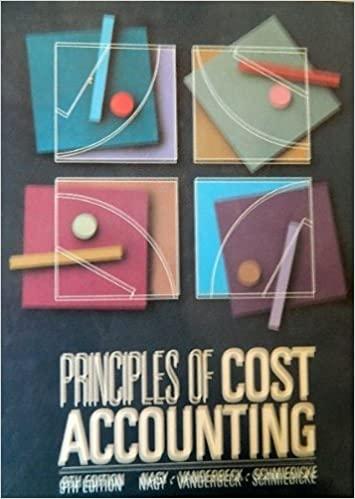Question
Financial statements of Par Corp. and its subsidiary Star Inc. on December 31, Year 12, are shown below: BALANCE SHEETS At December 31, Year 12
Financial statements of Par Corp. and its subsidiary Star Inc. on December 31, Year 12, are shown below:
| BALANCE SHEETS | ||||||
| At December 31, Year 12 | ||||||
| Par | Star | |||||
| Cash | $ | 40,000 | $ | 1,000 | ||
| Accounts receivable | 100,000 | 85,000 | ||||
| Inventories | 55,000 | 48,000 | ||||
| Land | 30,000 | 70,000 | ||||
| Plant and equipment | 400,000 | 700,000 | ||||
| Accumulated depreciation | (180,000 | ) | (300,000 | ) | ||
| Investment in Star common shares | 280,000 | |||||
| $ | 725,000 | $ | 604,000 | |||
| Accounts payable | $ | 92,000 | $ | 180,000 | ||
| Accrued liabilities | 8,000 | 10,000 | ||||
| Preferred shares | 50,000 | |||||
| Common shares | 450,000 | 200,000 | ||||
| Retained earnings | 175,000 | 164,000 | ||||
| $ | 725,000 | $ | 604,000 | |||
| RETAINED EARNINGS STATEMENTS | ||||||
| For the Year Ended December 31, Year 12 | ||||||
| Par | Star | |||||
| Balance, January 1 | $ | 195,000 | $ | 208,000 | ||
| Net income (loss) | 15,000 | (24,000 | ) | |||
| 210,000 | 184,000 | |||||
| Dividends | (35,000 | ) | (20,000 | ) | ||
| Balance, December 31 | $ | 175,000 | $ | 164,000 | ||
Other Information
On January 1, Year 5, the balance sheet of Star showed the following shareholders equity:
| $8 cumulative preferred shares, 500 shares issued | $ 50,000 |
| Common shares, 2,000 shares issued | 200,000 |
| Deficit (Note 1) | (80,000) |
| $170,000 | |
Note 1: Dividends on preferred shares are two years in arrears.
On this date, Par acquired 1,400 common shares of Star for a cash payment of $280,000.
The fair values of Stars identifiable net assets differed from carrying amounts only with respect to the following:
| Carrying amount | Fair value | |||||
| Accounts receivable | $ | 42,000 | $ | 40,000 | ||
| Inventory | 65,000 | 72,000 | ||||
| Plant | 600,000 | 650,000 | ||||
| Long-term liabilities | 400,000 | 420,000 | ||||
The plant had an estimated remaining useful life of five years on this date, and the long-term liabilities had a maturity date of December 30, Year 12. Any goodwill is to be tested annually for impairment.
Both Par and Star make substantial sales to each other at an intercompany selling price that yields the same gross profit as the sales they make to unrelated customers. Intercompany sales in Year 12 were as follows:
| Par to Star | $ 400,000 |
| Star to Par | 330,000 |
During Year 12, Par billed Star $2,000 per month in management fees. At year-end, Star had paid for all months except for December.
The January 1, Year 12, inventories of the two companies contained unrealized intercompany profits as follows:
| Inventory of Par | $ 30,000 |
| Inventory of Star | 21,000 |
The December 31, Year 12, inventories of the two companies contained unrealized intercompany profits as follows:
| Inventory of Par | $ 35,000 |
| Inventory of Star | 37,000 |
On July 1, Year 7, Star sold equipment to Par for $82,000. The equipment had a carrying amount in the records of Star of $60,000 on this date and an estimated remaining useful life of five years.
Goodwill impairment losses were recorded as follows: Year 7, $92,500; Year 9, $46,470; and Year 12, $19,710.
Assume a 40% corporate tax rate.
Par has accounted for its investment in Star by the cost method.
All dividends in arrears were paid by December 31, Year 11.
Required:
(a) Prepare, with all necessary calculations, the following:
(i) Year 12 consolidated retained earnings statement. (Input all amounts as positive values. Omit $ sign in your response.)
| Par Corp. | |
| Consolidated Retained Earnings Statement | |
| Year Ended December 31, Year 12 | |
| Balance January 1 | $ |
| Net loss | |
| Dividends | |
| Balance December 31 | $ |
(ii) Consolidated balance sheet as at December 31, Year 12.
(b) How would the return on equity attributable to Pars shareholders for Year 12 change if Stars preferred shares were non-cumulative instead of cumulative?
multiple choice 1
No Change
Change
(c) On January 1, Year 13, Star issued common shares for $100,000 in cash. Because Par did not purchase any of these shares, Pars ownership percentage declined from 70 to 56%.
Calculate the gain or loss that would be charged or credited to consolidated shareholders equity as a result of this transaction. (Input all amounts as positive values. Round intermediate calculations and final answer to nearest dollar amount. Omit $ sign in your response.)
(Click to select) Gain Loss $
Step by Step Solution
There are 3 Steps involved in it
Step: 1

Get Instant Access to Expert-Tailored Solutions
See step-by-step solutions with expert insights and AI powered tools for academic success
Step: 2

Step: 3

Ace Your Homework with AI
Get the answers you need in no time with our AI-driven, step-by-step assistance
Get Started


